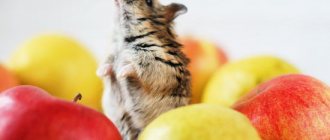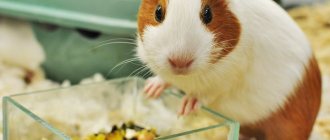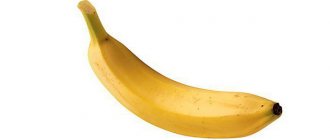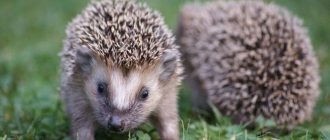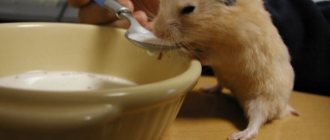To the main diet of rodents - a grain mixture, it is necessary to add vegetables, fruits and berries. They improve digestion and saturate the body with useful substances. Let's consider whether hamsters can eat strawberries, whether they are included in the list of foods allowed for hamsters, and whether they will bring benefit or harm to the pet.
Properties of strawberries and recommendations for adding them to a hamster’s diet
Strawberries contain a fairly large amount of vitamins A, C, E and group B. Its consumption has the following positive effects:
- improving the health of the heart muscle, visual organs, and liver;
- prevention of dysbacteriosis, vitamin deficiency, arthritis, diseases of the nervous system;
- preventing the birth of sick babies;
- prevention of cancer.
In addition, the berry has a diuretic effect due to the high percentage of water it contains and has a pronounced antimicrobial effect, which allows both maintaining the normal functioning of the animal’s urinary system and protecting it from various infectious diseases.
IMPORTANT! Despite the impressive list of beneficial qualities, strawberries should be given with caution, as they can cause an allergic reaction or cause digestive system upset.
For the first time, the hamster is given a small piece of berry to try to evaluate how his body will react to it. If the animal eats berries with great pleasure, and there are no health problems, then after a couple of days you can give him half a large or a whole small berry . You can treat your rodent only with well-washed strawberries.
IMPORTANT! To avoid intestinal problems, strawberries should be given no more than once every 2-3 days, and after the main meal.
The animal should not feel the beginning of the berry season on its diet. Also, do not forget to check the secluded places in your pet’s home. Rodents often stockpile food, and the berries spoil very quickly. You should not allow your hamster to eat spoiled food, as this will cause digestive upset and can even lead to serious poisoning.
You give your hamster sweet berries
You shouldn't buy strawberries at the market
How can it harm a hamster?
The main food for hamsters is grain plants. These rodents need solid food, so berries and fruits should make up a very small part of their diet. Strawberries are no exception.
With excessive consumption of this tasty berry, hamsters may experience the following problems:
- It contains sugars and glucose. If the hamster suffers from diabetes, then he cannot eat this berry.
- Diarrhea. Such a problem may deplete his body or cause other problems.
- The presence of acids in the composition somewhat irritates the mucous membranes of the digestive tract. This often leads to gastritis or stomach ulcers.
- Allergy. This product can also be an allergen in hamsters. If your pet has previously had allergic reactions, then it is better not to give him strawberries at all.
- Load on the kidneys. The composition contains about 90% water and contains potassium, which causes a diuretic effect. If the kidneys cannot cope with the heavy load, this can lead to the death of the animal.
All these side effects may not appear immediately, so you need to control the quality and quantity of this berry.
Important! Since hamsters can be allergic to strawberries and have indigestion, for the first time he needs to be given a very small piece of this berry. After this, his reactions should be monitored for 1–2 days.
What kind of strawberries can pets eat?
You can give strawberries to your hamster during the season of this berry - in the warm season. At the same time, it is better and safer to use strawberries collected in a clean place, ideally from your own plot or grown from relatives or friends. If this is not possible, and you have to buy berries on the market, do not take berries grown in greenhouses using fertilizers and stimulants.
IMPORTANT! When buying strawberries at the market, there is a risk of possible rodent poisoning, since these berries could be grown in the wrong place using harmful fertilizers
Strawberries can only be given in small portions
Can a hamster eat strawberries?
Your adorable hamsters can live a long and happy life if they eat healthy nutrients from vegetables and fruits. Fruit supplements are an important part of your beloved pets' diet. However, they should only be given to your hamster as a treat. You can feed your little pets delicious fruits such as strawberries, apples and pears a couple of times a week. When serving fruit, make sure it is cut into pieces for easier digestion. Because of this, small strawberry pieces are a suitable snack choice for your hamster.
It is better to avoid fruits such as lemon, tangerine and orange. They contain excessive amounts of citric acid and are dangerous for hamsters.
Features of feeding strawberries to Djungarian hamsters
Djungarian hamsters and their health characteristics are somewhat different from other types of hamsters. They are susceptible to diabetes, often suffer from obesity, arthritis, and colds. Therefore, they are not recommended to eat large amounts of sweet fruits and berries.
Strawberries can be included in the diet of Djungarians, but they must be offered in small portions. In this case, the sugar contained in it will not be able to harm the health of the rodent, and its beneficial properties will have a preventive effect and increase the animal’s immunity.
IMPORTANT! Giving Djungarian hamsters sweet berries is quite risky, and it is much safer to keep them on a special diet and avoid sweets.
Harmful properties
Despite the benefits, strawberries can be harmful to the hamster’s body:
- Gastrointestinal system disorders.
- Intoxication.
- Pain in the intestines.
- Increased body temperature.
- In addition, the berries contain a certain amount of sucrose, which negatively affects the formation of teeth and their deformation.
- The appearance of allergies.
- Diarrhea.
- Dehydration of the body.
Conclusion
The answer to the question whether it is possible to give strawberries to hamsters will be positive. This is tasty, healthy food, but you shouldn’t overdo it. You should treat your pet with such a delicacy in moderation, carefully monitoring the baby’s health.
Don't forget to check nooks and crannies in your pet's home. Rodents often store extra food for the future, and the berries spoil very quickly. You should not allow your baby to eat a spoiled product - this is fraught with digestive disorders and even serious poisoning.
Maybe
Vitamins, mineral supplements and treats
For the proper development and full functioning of the body of Syrian hamsters, it is necessary not only to feed them in a balanced manner, but also to provide them with special fortified preparations. They are available in solid and liquid form and are mixed into the animal’s drink or food.
A mineral stone is also placed in the pet's cage. It will not only help sharpen the incisors, but also enrich the body with essential substances. Pregnant females are given a chalk stone, which can have a fruity or herbal flavor and will provide the expectant mother with calcium and other trace elements.
As treats for your Syrian hamster, you can eat rose petals, unbuttered and salt-free popcorn, dried fruits, cereal sticks and fruit chips.
Choosing a variety
Which variety to choose for dzungaria and do you need to process the fruits? There is no need to choose varieties that are too sweet; your pet will like them, but they can be harmful to health. Too sour fruits are also not suitable; ripe, moderate-tasting fruits are best. If you choose a fruit that is not ripe enough, the animal may have digestive problems.
Regarding processing, the rules are:
- Store-bought apples must be peeled; the fruits may be treated with chemicals. This condition especially applies to fruits purchased in winter. In cold weather, it is better not to buy them for your pet.
- Homemade fruits must be washed.
- Dried apples are better for winter. Soak them in water before giving them to your hamster.
- Fruits must be washed thoroughly under running water.
Which hamster is better: Djungarian or Syrian
Both Djungarian and Syrian hamsters need proper care. To understand which hamster is best to get, the future owner must take into account his character and lifestyle.
If the owner spends the whole day at work or periodically leaves home for 1–2 days, then a dzhungarik will be more suitable for him. It is better to buy 2 hamsters from the same litter and place them in a spacious cage with separate accessories, then they are unlikely to conflict. If you provide them with food and drink, they will not even notice the absence of a person.
If the future owner wants to have contact with the animal, then the Syrian hamster will become an excellent friend. Some owners allow the animal to spend all its waking hours in freedom; they are sent into the cage only to sleep
The golden hamster meets the owner if he has gone somewhere, climbs into his arms, and attracts attention to himself
Parents are always unsure which hamster is better to buy for their child - Djungarian or Syrian. If the future owner is under 5 years old, then it is recommended to choose a Syrian.
He is larger, phlegmatic, and has good contact with people. But it is better to buy a pet no younger than 2 months. Using the example of a calm animal, a child will learn to care for rodents: clean the cage, feed.
Djungarians can easily escape from their little owner if he opens the cage to change the bedding or put in food
In addition, the latter can bite the child if handled carelessly, then stress is guaranteed for both
Which hamster is suitable for a child over 5 years old, he will decide for himself. The main thing is to teach him to be responsible and treat animals with care. Adults should supervise the care process.
The Syrian hamster is more suitable for children, as they love to cuddle, pet, play, and train. In addition, they live longer, and Djungarians often do not live up to 2 years
Thus, Djungarians are more suitable for adults who do not need physical contact, are often not at home, and can keep 2 pets. Syrian hamsters will bring joy to children and adults who want to pet, hold and train the animal.
In both cases, you need to provide the hamster with spacious housing, necessary accessories, proper care, care and love.
Fruits for your hamster
Hamsters can be given various fruits (with the exception of citrus and exotic ones), but in small doses. The high sugar content makes this complementary food unsafe. Domestic Djungarians are given less of it than individuals of the Syrian breed - within 5% of the main diet. Campbell's hamsters are fed even more carefully.
The main fruit products that are suitable for Syrian and Djungarian hamsters include:
- apple - choose sweet and sour varieties, introduce them from 4 months, do not give to lactating females;
- apricot – a little and not overripe, it is better to give dried apricots out of season;
- peach is better than nectarine, it has less sugar;
- pear – firm yellow or green, uncommon;
- banana – preferably a little greenish, just unripe;
- plum - a little at a time, so as not to provoke diarrhea;
- melon – due to excessive sweetness, allowed only once every 5-7 days;
- watermelon - also rare, but from your own garden (it’s hard to find a store-bought one without nitrates).
Berries will help diversify your diet. Strawberries are offered once every 7 days, a piece with a diameter of 1 cm. The rest of the berries from the list are given 1 piece per week, the portion for the Syrian hamster is doubled. Allowed:
- cherries and sweet cherries (pits removed);
- currant;
- not sour gooseberries;
- grape;
- raspberries;
- blueberry;
- blackberry;
- cowberry;
- blueberry.
Of all of the above, only dietary fruits are suitable for Campbell's hamsters. These are nectarine, blueberry, lingonberry, cherry, hawthorn. It is worth remembering that exotic fruits (mango, avocado, kiwi, pineapple and others) are prohibited from being offered to all rodents. They can cause severe allergic reactions and digestive problems.
What to feed sick and weakened rodents
The menu for sick and weakened pets depends on the nature of the pathology. For example, if an animal has lost its incisors, solid food is contraindicated until new teeth grow. For diarrhea, before visiting the veterinarian, give boiled rice, rice water and chamomile infusion. For pain, offer soft, tasty and easy to eat food. For example, meat purees and porridges.
Exhausted and weakened pets must first be forced to eat. In critical condition, the animal begins to prepare for hibernation. This is the last attempt to survive.
To prevent your pet from falling asleep, pour a lot of grain food into the cage. This will create the appearance of large reserves and relieve stress. Peeled oats and wheat are suitable for feeding; you can add some peas and corn.
After getting out of a stressful state, the hamster stops intensively stocking up. He needs to be given high-calorie, tasty food for 2-3 weeks. Softened porridges and purees are suitable. There should always be food in the tray.
The fact that the hamster is not feeling well can be indicated by its lethargic state and refusal to eat.
Results
Can hamsters eat strawberries? Yes. Especially if it is from your garden or purchased from a trusted seller. Half a large berry in one to two days in the evening diet is enough for a hamster to get the benefit and avoid negative consequences in the form of an upset stomach.
Did you like the article? Share with friends: [supsystic-social-sharing id=”1"]
- Related Posts
- Can hamsters eat pomegranate?
- Can hamsters eat cabbage?
- Can hamsters eat zucchini?
« Previous entry
Harm of strawberries for hamsters
Although strawberries are the perfect fruity treat for your cute hamsters, there are certain contraindications that cannot simply be ignored. Recent studies show that strawberries contain higher residual levels of pesticides, which are enough to quickly kill your precious pets. Always wash strawberries thoroughly before serving them to your hamsters. Always try to buy organic strawberries at a farmers market. Strawberries also contain harmful chemicals such as beta blockers in higher doses that can seriously affect your pets' health. Therefore, it is best to serve your hamsters strawberries grown in your garden only when they are as free as possible from harmful pesticides or other chemicals.
Dried fruits
Hamsters can occasionally be pampered with dried fruits (dried apricots, raisins, fruit chips). But you can’t get carried away with them, since the sugar content in them is high. In addition to raisins, Syrian hamsters are given a little dried apricots. For miniature jungarians, who are more prone to obesity, it is better to offer less sweet dried pieces of apples or bananas. But prunes are contraindicated for hamsters; it is better to avoid them completely.
Banana chips are already included in some ready-made feed mixtures.
What berries can you give?
Juicy seasonal berries should undoubtedly be present in a hamster's diet, because they are a rich source of a wide range of vitamins and minerals. Eating them helps keep the immune system in order; you are allowed to treat:
- wild forest rowan;
- blackberries;
- strawberries;
- blueberries;
- cranberries;
- strawberries;
- white and red currants.
In very limited quantities, the hamster is occasionally given the following berries:
- lingonberries;
- blueberries;
- chokeberry;
- ripe unsweetened grapes (seedless);
- pitted cherries and cherries;
- raspberries;
- gooseberry;
- black currants.
Methods for storing strawberries
If your hamsters show no interest in the strawberries you bought, don't be discouraged as they may simply not be in the mood to eat them at the moment. You can save the berries until your pet wants to try them. There are three main steps you can follow for this purpose:
- If you store strawberries in the refrigerator, try not to wash them. Increased moisture accumulation can easily damage the berries. It's best to dry out any excess moisture before putting the strawberries in the refrigerator.
- If you notice damaged or spoiled berries, remove them from the total mass. Otherwise, they will spoil the rest of the strawberries even inside the refrigerator.
- Store berries in a container that allows free air flow inside. Lack of air often causes strawberries to rot quickly when stored in airtight containers.

